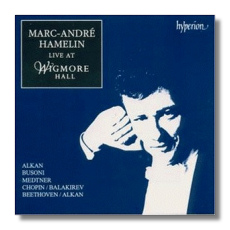
The Internet's Premier Classical Music Source
Related Links
- Latest Reviews
- More Reviews
-
By Composer
-
Collections
DVD & Blu-ray
Books
Concert Reviews
Articles/Interviews
Software
Audio
Search Amazon
Recommended Links
Site News
 CD Review
CD Review
Marc-André Hamelin

Live at Wigmore Hall
- Ludwig van Beethoven: First movement from Piano Concerto #3 (trans. Alkan)
- Frédéric Chopin: Romanza from Piano Concerto #1 (trans. Balakirev)
- Charles-Valentin Alkan: Trois Grande Études, Op. 76
- Ferruccio Busoni: Sonatina #6: Kammer-Fantasie über Carmen
- Nicolai Medtner: Danza festiva, Op. 38/3
Marc-André Hamelin, piano
Hyperion CDA66765 Time: 71:56 DDD
This recital should stand as one of the great documents of live performance in the last twenty years. Had Hamelin essayed more popular repertoire - instead of headlining with "Alkan, who?" - he might have received wider notice. To the 19th Century truffle hunters who are his fans, his reputation is ever-burnished.
"Live at Wigmore Hall" is culled from three recitals presented in June 1994. The programs, designed by producer Ates Orga, bore fanciful titles: The Concert Room, Grand Opera and Song, and The Salon.
The music, much of it transcription, is by composer-performers who pushed the boundaries of their art. Charles-Valentin Alkan (1813-1888), the reclusive French virtuoso and a Hamelin staple, figures largely. His massive conceptions challenge the listener's appreciation of music itself. Take for example the cadenza to Alkan's transcription of the first movement of the Beethoven Piano Concerto #3. Along with the typical recap of the main themes, Alkan maniacally conjoins Beethoven's Fifth symphony for even starker dramatic relief. It lasts six minutes, one third of the entire piece. Hamelin fills the hall with sound, his total control casting an icy glitter. Who is Alkan's audience? In the composer's day, few performers would even attempt these works in public. The rewards of playing them seemed apparent only to a few discerning artists, Franz Liszt among them. Busoni and Petri kept Alkan alive in the early part of our century; Raymond Lewenthal was the first to make extensive recordings in the Sixties; recent champions include pianist-scholar Ronald Smith and Hamelin.
After dispatching that monster, Hamelin relaxes with the fragrant Balakirev reduction of the "Romanza" from Chopin's Piano Concerto #1. It's the least removed from the original of the transcriptions played here. The main course is next: Alkan's "Tres Grandes Études" for the hands separately and united. The gauche étude precedes by sixty years the popularity of left hand works, and it's likely nothing written since has been as formidable. At one point, Hamelin negotiates what has to be two pages of leaps in bristling chords. When I first heard it I thought I detected some hesitation on his part; I now chalk it up to rubato! As the heroic chords draw to a close silence. Perhaps Hamelin takes a drink of water here. Then the right hand has its say in a fifteen minute novella of arpeggio studies and five-fingered counterpoint. The music becomes a test of will. As Hamelin lifts his hands from the keys, concluding yet another ringing coda, we can imagine him waving off first aid. He pounces again; beginning from a hush, the soft pedal fully engaged, the hands-united étude emerges, whirring like a dynamo. For some five minutes, the notes whip by at a speed that threatens to invoke relativity. The musical quotient dips a bit here, but in the blistering parallel scales, Alkan does his countryman Charles Hanon proud. Then, abruptly, it's over. The audience sighs with relief, and seeing that Hamelin is free of demonic possession, erupts in applause.
Dessert is sweet. Hamelin shows a beguiling tone in the Busoni "Carmen" Sonatina which treats some of Bizet's familiar themes with mordant éclat. Medtner's "Danza Festiva" closes the program with a whirl.
I hope this pseudo-correspondence gives a sense of the occasion and magnetism generated by these performances. Not all the music is inspired, but Hyperion is to be congratulated for staging this high-wire act. Bravo, Mr. Hamelin!
Copyright © 1998, Robert J. Sullivan


















